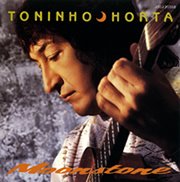
Clique aqui para baixar o disco/Download the album - RapidShare
........................................................
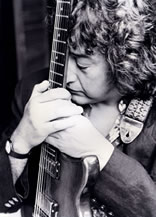 Antônio Maurício Horta de Melo nasceu em Belo Horizonte, no bairro Floresta, em 2 de dezembro de 1948. Filho de Prudente de Melo, mestre-de-obras, e Geralda Magela Horta de Melo, funcionária pública. Seu pai tocava violão e a mãe, violão e bandolim. O primeiro músico da família foi o avô materno, João Horta, funcionário da Central do Brasil que montava uma banda em cada lugar em que morava. Paulo, um de seus cinco irmãos, foi quem mais o incentivou para música. Aos 10 anos, Toninho começou a tocar violão e, aos 13, fez sua primeira composição, "Barquinho Vem". Aos 19 anos, iniciou a carreira de músico profissional tocando na noite. Na adolescência, conheceu Milton Nascimento, Márcio e Lô Borges e Beto Guedes – aos dois últimos ensinou harmonia. Mas foi a partir do Festival de Belo Horizonte, em 1969, que começou a união musical do grupo. No final dos anos 60, foi para o Rio de Janeiro, onde trabalhou com artistas como Elis Regina. Em 1972, organizou arranjos de base, tocou guitarra, baixo e percussão no disco Clube da Esquina. Após 10 anos nos EUA, em 1999 retornou ao Brasil com uma carreira internacional consolidada. Hoje dedica-se ao seu selo Minas Records e a publicação do Livrão da Música Brasileira, compilação de cerca de 700 partituras, abrangendo desde Carlos Gomes até compositores contemporâneos.
Antônio Maurício Horta de Melo nasceu em Belo Horizonte, no bairro Floresta, em 2 de dezembro de 1948. Filho de Prudente de Melo, mestre-de-obras, e Geralda Magela Horta de Melo, funcionária pública. Seu pai tocava violão e a mãe, violão e bandolim. O primeiro músico da família foi o avô materno, João Horta, funcionário da Central do Brasil que montava uma banda em cada lugar em que morava. Paulo, um de seus cinco irmãos, foi quem mais o incentivou para música. Aos 10 anos, Toninho começou a tocar violão e, aos 13, fez sua primeira composição, "Barquinho Vem". Aos 19 anos, iniciou a carreira de músico profissional tocando na noite. Na adolescência, conheceu Milton Nascimento, Márcio e Lô Borges e Beto Guedes – aos dois últimos ensinou harmonia. Mas foi a partir do Festival de Belo Horizonte, em 1969, que começou a união musical do grupo. No final dos anos 60, foi para o Rio de Janeiro, onde trabalhou com artistas como Elis Regina. Em 1972, organizou arranjos de base, tocou guitarra, baixo e percussão no disco Clube da Esquina. Após 10 anos nos EUA, em 1999 retornou ao Brasil com uma carreira internacional consolidada. Hoje dedica-se ao seu selo Minas Records e a publicação do Livrão da Música Brasileira, compilação de cerca de 700 partituras, abrangendo desde Carlos Gomes até compositores contemporâneos.Para mais informação, visite os sites:
A Música Audaz de Toninho Horta
Toninho Horta - The music of Minas Gerais
************************
The sound of Brazil are ringing together from its deepest reaches. Few feel its diverstity more intimately than Toninho Horta, whose elegant regional colors have been global ambassadors of the country's rich musical gifts for decades.
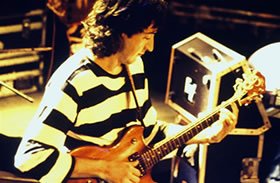 Horta embraces the most beautiful gestures of fingerstyle bossa nova, accompanying his own vocal lines with a grace that transcends mere harmonization; at a turn, he dispatches felt-toned octaves in soaring bop mode that utterly desegrates the invocations of jazz, classical, folk and african rythms within his shifting, surreal progressions. "I love to show a conception of my music", asserts Horta in an English riddled with the dialect of his native Belo Horizonte, the capital of the Brazilian state Minas Gerais. "That's much more meaningful to me than to just play guitar".
Horta embraces the most beautiful gestures of fingerstyle bossa nova, accompanying his own vocal lines with a grace that transcends mere harmonization; at a turn, he dispatches felt-toned octaves in soaring bop mode that utterly desegrates the invocations of jazz, classical, folk and african rythms within his shifting, surreal progressions. "I love to show a conception of my music", asserts Horta in an English riddled with the dialect of his native Belo Horizonte, the capital of the Brazilian state Minas Gerais. "That's much more meaningful to me than to just play guitar".Although his compositions and fluent playing brought him recognition from Belo Horizonte to Rio de Janeiro, it wasn't until Milton Nascimento's popular breakthrough that the city-and Horta especially-became a touchstone for a growing international awareness of Brazilian music. Horta accompanied Nascimento in 1970 for the singer's very first performance in Rio, and two years later participated in the making of the landmark recording Clube da Esquina. Toninho's first solo album Terra dos Passaros was recorded during a period when his works were being covered by everyone from Sergio Mendes to Flora Purim to Norman Connors' Starship Orchestra.
A self titled follow-up, released in 1980, featured the contributions of a professed Horta disciple whose own music has carried that pervasive influence to audiences worldwide: Pat Metheny.
When Toninho immigrated to New York in the mid '80s, he spent time in the clubs alongside two former Pat Metheny Group members, drummer Danny Gottlieb and bassist Mark Egan, as well as percussionist Manolo Badrena. To hone his craft, he did two taxing semesters at the Juilliard School. "When I took the placement tests, he laughs, "they said, Ah, you don't know anything about music! And you have to start again with the rudiments if you want to study here. It was very strange, but it was an interesting experience."
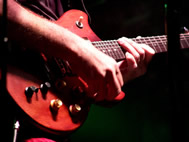 Diamond Land, Toninho's American label debut of last year, represented the results of his dabblings in orchestral study: Its lush, sweeping arrangements are propelled by a guitar voice that sings his melodies with a provocative sweetness. Moonstone is a return to the intimate setting that lends a more organic quality to Horta's compositions, several of which he performed unaccompanied at the urging of producer Ricardo Silveira, a fine Brazilian guitarist in his own right. For the ensemble pieces, Toninho is joined again by Egan and Gottlieb, along with the Brazilian vocal group Boca Livre, drummer Paulo Braga, bassist Steve Rodby, pianist Eliane Elias and percussionist Nana Vasconcelos, among many other stylistically diverse musicians.
Diamond Land, Toninho's American label debut of last year, represented the results of his dabblings in orchestral study: Its lush, sweeping arrangements are propelled by a guitar voice that sings his melodies with a provocative sweetness. Moonstone is a return to the intimate setting that lends a more organic quality to Horta's compositions, several of which he performed unaccompanied at the urging of producer Ricardo Silveira, a fine Brazilian guitarist in his own right. For the ensemble pieces, Toninho is joined again by Egan and Gottlieb, along with the Brazilian vocal group Boca Livre, drummer Paulo Braga, bassist Steve Rodby, pianist Eliane Elias and percussionist Nana Vasconcelos, among many other stylistically diverse musicians. The record is an exquisite statement of melody and mood; on the title track, Horta reunites with Metheny-whom Toninho is often surprisingly said to "sound like"- for a subtle acoustic dialog that brings the two guitarists together more inseparably than ever before. "A lot of people I speak to make the comparison", Toninho smiles, "but there are many guys who play the electric guitar more similarly to the way I do, like John Abercrombie. Lee Ritenour came to see my show in California, and Al di Meola saw me recently, and the guys loved the stuff. Lee told Ricardo, 'Toninho's incredible because he doesn't play licks'. I try not to sound like anybody else, and I prefer to make my mistakes and have more limited playing in terms of scales. I don't want to play licks. It's good, but I never want to do it. I have my licks, "he laughs, "but that's my way".
Why the more focused approach?
I've always loved orchestration. When I was very young, between 10 and 13, I listened to much American stuff, like Stan Kenton, Stan Getz, Nelson Riddle, Ella Fitzgerald and I loved the big arrangements. Then one day I started playing guitar, and realized it's better to use six strings most of the time: I'd play with five fingers of the right hand to make a big sound, and use a lot of open strings to get more of an orchestrated sound. On both of the records I did in Brazil, and Diamond Land, I put too much (laughs). I had the opportunity to show my stuff playing-wise, but also to invite friends to play with me in the kinds of music that enjoys a lot of orchestration-very full. But Ricardo told me, "Toninho, you have to concentrate more on yourself now, on playing more". and besides, I promised the people at the record company that on the next album, I'd make it all just myself, and maybe some decoration. But between the last album and Moonstone, I'm more focused in my music, because I think the people in the company and maybe the United States want to listen more to me than a lot of stuff around it.
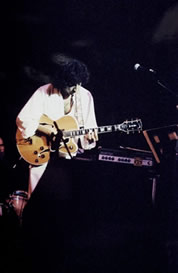 I love to play guitar, but I don't think I'd want to be a guitarist like Pat Metheny, because I like composing, singing, playing piano, production-I co-produced the first album I did here. But I thought I'd make it more simple, with less outside people, to show more of the styles, acoustic and electric, that I can play.
I love to play guitar, but I don't think I'd want to be a guitarist like Pat Metheny, because I like composing, singing, playing piano, production-I co-produced the first album I did here. But I thought I'd make it more simple, with less outside people, to show more of the styles, acoustic and electric, that I can play.If you were to make a record that would really represent Toninho Horta, would it involve just singing and playing acoustic guitar?
Yeah. What got me into playing electric guitar was hearing people like Wes Montgomery, Barney Kessel and Tal Farlow. But I never took lessons, I just listened a lot. I started when I was 15 years old. My older brother Paulo is a bass player, and he's got a lot of American records. I listened all the time, but never copied one phrase from those guys. Maybe one chord. But I just listened and listened, and I never got a teacher in Brazil. And I really listened to Brazilian musicians, guitar players like Baden Powell, Chiquito Braga, Joao Gilberto, of course, and Jorge Ben. Growing up in Belo Horizonte, I met many musicians, but I found my style maybe when I was 18; at that time people said 'Toninho, you've got good harmony, god ways of music'. I would like to have studied then, but it's good now.
Some musicians have a creeping fear that if they learn the musical language, they'll get taken in by all the rules and find it more difficult to express themselvs. Did you experience that while studying at Juilliard?
Well, I got into a lot of orchestration, but then again, my idea was only to stay in Juilliard for a short time. I took an exam there, and it was so bad, even though I studied in Brazil in a private theory class for about two months before. At Juilliard, I made it through the beginning of harmony in four voices. I had a good time, and my teacher, a conductor named C.Jeffrey Langley, told me, "You don't need this", he made tests of all the others in the class, and they all knew that a Bb major scale had these notes with the accidentals or whatever, but when he started a test at the piano, on singing and identifying notes, I was always the best of the class. I have no theory, but a lot of experience. But I had a good time there; it helped in, learning to write better. A little bit, not too much (laughs).
Did it help your playing?
For playing, no, and for composing, no. Just for writing and understanding something about basic theory. But for applications like playing my music with other guys, definetely not.
Because studying harmony strengthens arranging skills, it also often helps guitarists learn more about moving the differents voices around on the instrument. Didn't your solo playing benefit from that?
Of course, but not intentionally. I always prefer a more natural sound. I've listened to all kinds of music at all times in my life. Right now, I listen to (arranger) Claus Ogerman and think about it, and that helps translate ideas, just keeping information. But when I sit with the guitar to compose a song, I never remember any scale or musician. I just play; maybe an old song of mine, or one by Antonio Jobim or Jorge Ben or Cole Porter (sings Porter's "I love you") - I love that song. Then I start to improvise lines, find some idea, and then I open my mind and start to compose. But I never decide, "Oh, now I'm going to compose a 6/8 song. " I once wrote for a small symphony in Campinas the second biggest city in Sao Paulo. It was a piece called "Earth", in four movements, and in this kind of work, you have to concentrate: I wanted to start with a big earthy sound, and then a happy song, so I had to compose a slightly faster part, and then be able to create sadness. I can work in a focused style, but I never think about the time, the rythm, or the chords. I just compose and play. It's easier for me, and it's best for the people who listen. It seems so natural.
When you compose, do you create the melody first and then build an accompaniment around it?
It all comes at the same time. Always together. Melody, harmony, and rythms.
When you came over to America, did people immediately compare your style to Pat Metheny's?
Yeah, of course. All the time (laughs). The first time I heard it it bothered me, but not now, because it happened so much that I got used to it. Pat and I have the same idols on guitar, and he's self taught, too. Like I said, I started when I was very young-my brother and mother showed me some chords. So Pat and I have some similarities. I met him in 1980 in Brazil: Celia Vaz, a brazilian guitar player who studied with Pat at Berklee, introduced us, and the first time we got together, he loved me as a person and for my playing. I loved him too-I bought Pat Metheny Group and American Garage (both on ECM) before I went to see him. And I remember saying, "If only someday I can play with Mark Egan (laughs)! "It was incredible because after we played together the first time, he said, "Toninho, would you like to make a record?" Some people told me that Pat and (Pat Metheny Group keyboardist) Lyle Mays, when they were at Berklee in 1972 and 1973, had Milton's first album, Clube da Esquina, which they bought in Brazil, and after that, they started to listening to Brazilian music, and more from the composers of Minas gerais. Since that time, he has gotten into many interesting records.
 When Pat and Lyle came to Brazil, they said " Let's go to Clube Da Esquina to take pictures", but esquina is just a corner; it doesn't have a club (laughs), it's only a name. Close to the Minas Gerais corner in Brazil, there was a house belonging to (singer) Lo Borges' family: his father, his brothers, everybody playing and singing and writing songs, and sometimes I'd go and play with them. People would come and play until Milton broke out in Brazil in 1967, and then we started to play with him. I think my similarity to Pat is more natural than anything else. I loved him, and I never listened to just one solo. He's listened to my stuff a lot, but I don't think he copied anything. It's a similarity of emotion.
When Pat and Lyle came to Brazil, they said " Let's go to Clube Da Esquina to take pictures", but esquina is just a corner; it doesn't have a club (laughs), it's only a name. Close to the Minas Gerais corner in Brazil, there was a house belonging to (singer) Lo Borges' family: his father, his brothers, everybody playing and singing and writing songs, and sometimes I'd go and play with them. People would come and play until Milton broke out in Brazil in 1967, and then we started to play with him. I think my similarity to Pat is more natural than anything else. I loved him, and I never listened to just one solo. He's listened to my stuff a lot, but I don't think he copied anything. It's a similarity of emotion.Did you improvise "Moonstone", your duet with Pat?
He's known the song from a long time ago. He invited me to play with him at the wedding of (actor) Robert Duvall. I played acoustic and he played electric. Pat always loved that song. And when he came to record my album, I asked, "Pat, what are we going to play-maybe 'Diana'? Because he also liked that one, and I never recorded it in the States. We played that and another song, and then we just started playing "Moonstone". We just started playing it. He gave some ideas about the form, then he improvised, then I improvised, then we played together, just very simple. We made six takes, and used the fourth one. I'm happy because Ricardo originally thought Pat wouldn't play on the record, but we are friends, and it's good because we wouldn't otherwise have had the opportunity to get together. We had a great time there.
Do you play a custom acoustic?
I use an Hermanos Conde, from Madrid, Spain. It's a flamenco guitar. Paco De Lucia may use a similar one, but his model is more classical. Mine is flamenco.
What's the difference?
It's cheaper and lighter. and the classical has a slightly wider neck. But for me, it's perfect because it's very easy to play. I don't have nails, and the guitar is very flat and easy to get at. For recording, it's very nice. I never use a pick with acoustic-only fingers.
Do you amplify that guitar?
No, I like it direct. I sometimes use an equalizer, a very old 6-band MXR pedal. But I have a Shadow pickup on the Hermanos Conde, and they might use a Boss DD-3 digital delay. For this album, I also played a Roland GR-303 guitar, but I only use the syntheseizer part once or twice a year. I use plain guitar, maybe some chorus, but not too much, through a Roland JC-120 amp. I used that for "Francisca," "Bycycle Ride". On "Liana", I used a 1959 Telecaster, which I borrowed from the studio owner, for a slightly brighter sound. Some people brought a (Gibson) ES-175 just for the recording, which I played on "Yarabela" and "Spirit Land", but then I decided to use only acoustic on that song. Then my Hermanos Conde cracked while recording, and I had to get another instrument. My friend lent me an acoustic/electric Takamine for the last two songs I did, "Gershwin" and "Saguin", which I performed by myself. It sounded a little different, with a little more middle, but it's okay. The music is more important than the equipment.
Have you ever worked with Joe Pass?
I met him at G.I.T. in California, where I did a seminar with Abe Laboriel. I met some guys from Brazil there around '83, and was supposed to come and do a seminar on Brazilian music, but I didn't have any time. Then a friend introduced me to Joe Pass the same week, who told me that Abe was doing a seminar for Latin music and asked if I would get involved. Larry Carlton was there (drummer) Ralph Humphrey, and a percussionist, and I played "I love you", I played a solo only with chords, and the people loved it. I have a tape of the people (mimics wild crowd noice). 300 guitar players in G.IT., never heard a chord solo!
Your Latino rythms must have freaked everybody out?
Yeah (sings straight ahead jazz rythms, then more anticipated rythms). It's got the feeling of jazz, but with special syncopations all over the place. The United States is incredible. When I was very young, I listened to all sorts its music, and it's great to get the opportunity to play my music here.
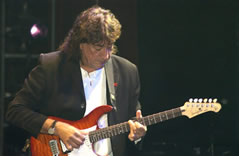 I worked in Rio for 10 years, and my producer told me, "Your place is the United States, not Brazil. "In Brazil there aremany good musicians and a lot of rythms, like baiao, samba, modinha- because Brazil is so big. The north is heavy influenced by Africa. The state of Bahia has african influences, and instruments like the congas (sings percussively)- Minas Gerais, my state, is heavily influenced by Spain and Portugal. Modinhas are like waltzes- not like jazz waltz-but Chorinhos and Modinhas have many influences from Spain and Portugal; mandolins, violins and guitar for example. The melodies and rythms are very Spanish. The rythms are very folk-song-like. And Rio de Janeiro has a more urban influence. Brazil is great musically, but to make music there, it's very, very hard, economically, politically, and socially. You see, you> have contemporary jazz, rock and pop. In Brazil now, we have instrumental music (laughs). The musicians don't have many opportunities, and to play at nights at clubs is hard. Also, there isn't much information. Here, you can buy the records of John Coltrane or Chopin or debussy, and you have the solos of Tal Farlow and Barney Kessel and Joe Pass. And the Berklee school, you get a thousand people playing the same thing, which actually is kind of bad. In Brazil, you don't have this, because it's hard to get a teacher and have big schools and information and books. I hope to release in Brazil a Real Book with about 350 songs by composers from Minas Gerais. Many important guys have risen from Brazil. The cultural secretary of Minas Gerais may be able to give the money for the project. It's important for the United States, because Brazilian music is better here again now, and there is interest in these harmonies and melodies.
I worked in Rio for 10 years, and my producer told me, "Your place is the United States, not Brazil. "In Brazil there aremany good musicians and a lot of rythms, like baiao, samba, modinha- because Brazil is so big. The north is heavy influenced by Africa. The state of Bahia has african influences, and instruments like the congas (sings percussively)- Minas Gerais, my state, is heavily influenced by Spain and Portugal. Modinhas are like waltzes- not like jazz waltz-but Chorinhos and Modinhas have many influences from Spain and Portugal; mandolins, violins and guitar for example. The melodies and rythms are very Spanish. The rythms are very folk-song-like. And Rio de Janeiro has a more urban influence. Brazil is great musically, but to make music there, it's very, very hard, economically, politically, and socially. You see, you> have contemporary jazz, rock and pop. In Brazil now, we have instrumental music (laughs). The musicians don't have many opportunities, and to play at nights at clubs is hard. Also, there isn't much information. Here, you can buy the records of John Coltrane or Chopin or debussy, and you have the solos of Tal Farlow and Barney Kessel and Joe Pass. And the Berklee school, you get a thousand people playing the same thing, which actually is kind of bad. In Brazil, you don't have this, because it's hard to get a teacher and have big schools and information and books. I hope to release in Brazil a Real Book with about 350 songs by composers from Minas Gerais. Many important guys have risen from Brazil. The cultural secretary of Minas Gerais may be able to give the money for the project. It's important for the United States, because Brazilian music is better here again now, and there is interest in these harmonies and melodies.Do you feel a responsability to the music of Brazil, or are your own concepts and playing your priorities now?
I have to be true, because until now, I haven't in a way. If I didn't make a record with more of myself playing, it's because I sometims feel insecure. When I play guitar and sing, or I accompany another person, it's easy for me. But when I have to play my music, play the melody and improvise, it's more difficult. This may be because until now, I've used too many people playing with me on a record, just because I loved it. But I never prepared much forehand. I find the songs and the form, but most of the time I write in the studio:"Oh, you just played it! Improvise here, make fills here, and if you want to, change it!" I like to show my music, and I am not interested in particular aspects. I have to concentrate more on playing than on the conception of the songs, but that's okay. Each of us has his own way. 100,000 people can play with more technique and ideas than I can, but I think when I play a phrase, I play it my way, and nobody plays like that but me.
For more info, visit:
A Música Audaz de Toninho Horta
Toninho Horta - The music of Minas Gerais
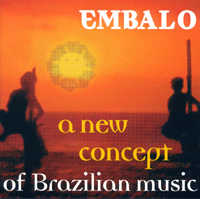
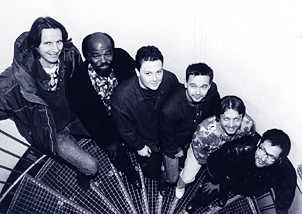 "Em 1969, viajei com o conjunto A Brasiliana para uma turnê na Europa, que durou cinco anos", conta Julio. "Fiquei na Alemanha porque me ofereceram inúmeras oportunidades de trabalho."
"Em 1969, viajei com o conjunto A Brasiliana para uma turnê na Europa, que durou cinco anos", conta Julio. "Fiquei na Alemanha porque me ofereceram inúmeras oportunidades de trabalho."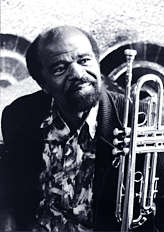 Thrilling and funky Brazil jazz by Munich-based sextet Embalo. Band leader, composer and arranger Julio Barbosa from Rio de Janeiro is an agile trumpet player who has worked with Sergio Mendes, Purim/Moreira, Paulo Moura, and Deodato, among others. The other band members are at the same top level, so I am surprised that this CD has not yet been published by an international label. The taut energetic playing, the catchy melodies with effective breaks and rhythm changes, complete with jubilant improvisations by all band members, who will not even in the most exuberant samba-fusion ever lose the central thread: All this guarantees a truly liberating listening experience.
Thrilling and funky Brazil jazz by Munich-based sextet Embalo. Band leader, composer and arranger Julio Barbosa from Rio de Janeiro is an agile trumpet player who has worked with Sergio Mendes, Purim/Moreira, Paulo Moura, and Deodato, among others. The other band members are at the same top level, so I am surprised that this CD has not yet been published by an international label. The taut energetic playing, the catchy melodies with effective breaks and rhythm changes, complete with jubilant improvisations by all band members, who will not even in the most exuberant samba-fusion ever lose the central thread: All this guarantees a truly liberating listening experience.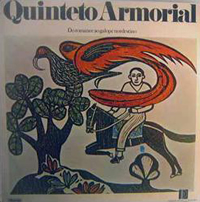
 Quantas vezes, na história de qualquer país do mundo, se conseguiu fundir em uma dúzia de peças musicais o regional no universal, e o popular no erudito? A julgar pela trajetória da cultura ocidental, onde a tendência da diversificação social urbana é sempre a de afastar os dois tipos de criação, através do alargamento das distancias entre povo e elite, esses momentos de reconhecimento mútuo de padrões culturais comuns não foram muitos. Por isso mesmo, o aparecimento de um desses raros exemplos no Brasil - neste mesmo instante em que a tendência é considerar "universal" a média descaracterizadamente musical produzida ao nível da cultura de massa - só pode ser saudado como um milagre.
Quantas vezes, na história de qualquer país do mundo, se conseguiu fundir em uma dúzia de peças musicais o regional no universal, e o popular no erudito? A julgar pela trajetória da cultura ocidental, onde a tendência da diversificação social urbana é sempre a de afastar os dois tipos de criação, através do alargamento das distancias entre povo e elite, esses momentos de reconhecimento mútuo de padrões culturais comuns não foram muitos. Por isso mesmo, o aparecimento de um desses raros exemplos no Brasil - neste mesmo instante em que a tendência é considerar "universal" a média descaracterizadamente musical produzida ao nível da cultura de massa - só pode ser saudado como um milagre. 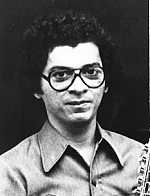 One of the most important groups that brought together Brazilian classical and popular/folkloric musics, the Quinteto Armorial was derived from the Armorial Movement, led by Ariano Suassuna. Their work consisted of the adaptation and execution of Brazilian Renaissance pieces and European medieval-influenced ones, inspired by the Northeastern folklore. Formed in 1970, the first formation of the Quinteto Armorial was absorbed by the Orquestra Armorial de Câmara, which performed in Rio de Janeiro and São Paulo. The group was awarded with the São Paulo's Association of Art Critics' award (APCA) in 1974, the year in which they recorded Quinteto Armorial — Do Romance ao Galope Nordestino (Marcus Pereira). They recorded three more albums until 1980, when was dissolved.
One of the most important groups that brought together Brazilian classical and popular/folkloric musics, the Quinteto Armorial was derived from the Armorial Movement, led by Ariano Suassuna. Their work consisted of the adaptation and execution of Brazilian Renaissance pieces and European medieval-influenced ones, inspired by the Northeastern folklore. Formed in 1970, the first formation of the Quinteto Armorial was absorbed by the Orquestra Armorial de Câmara, which performed in Rio de Janeiro and São Paulo. The group was awarded with the São Paulo's Association of Art Critics' award (APCA) in 1974, the year in which they recorded Quinteto Armorial — Do Romance ao Galope Nordestino (Marcus Pereira). They recorded three more albums until 1980, when was dissolved.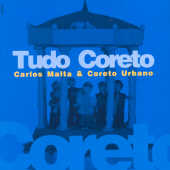
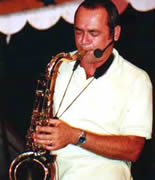 Se tem alguém que vive - literalmente - de música, é Carlos Malta. Autodidata, toca todos os tipos de saxofone e flautas. Ex-músico de Hermeto Pascoal, arranjador e compositor, criou os grupos Coreto Urbano e Pife Muderno. Agora, ele lança o CD Tudo Coreto, pelo selo Rádio MEC, ao lado dos músicos do Coreto Urbano. "O grupo nasceu em 94 e um dos objetivos era dar asas à minha veia de arranjador, possibilitando explorar os instrumentos de forma incomum", conta Malta. Para alcançar esse resultado, foram reunidos instrumentistas com trabalhos solidificados em orquestra sinfônica: Eliezer Rodrigues, Lulu Pereira, Carlos Vega, André Boxexa, Rodolfo Cardoso, Nelson de Oliveira, Oscar Bolão, Sérgio de Jesus e Dirceu Leite. "Para eles foi muito interessante, pois ao contrário das orquestras, onde ficam esperando sua vez para tocar, no grupo trabalham o tempo todo!", brinca, destacando que a banda é a única no mundo com esta formação.
Se tem alguém que vive - literalmente - de música, é Carlos Malta. Autodidata, toca todos os tipos de saxofone e flautas. Ex-músico de Hermeto Pascoal, arranjador e compositor, criou os grupos Coreto Urbano e Pife Muderno. Agora, ele lança o CD Tudo Coreto, pelo selo Rádio MEC, ao lado dos músicos do Coreto Urbano. "O grupo nasceu em 94 e um dos objetivos era dar asas à minha veia de arranjador, possibilitando explorar os instrumentos de forma incomum", conta Malta. Para alcançar esse resultado, foram reunidos instrumentistas com trabalhos solidificados em orquestra sinfônica: Eliezer Rodrigues, Lulu Pereira, Carlos Vega, André Boxexa, Rodolfo Cardoso, Nelson de Oliveira, Oscar Bolão, Sérgio de Jesus e Dirceu Leite. "Para eles foi muito interessante, pois ao contrário das orquestras, onde ficam esperando sua vez para tocar, no grupo trabalham o tempo todo!", brinca, destacando que a banda é a única no mundo com esta formação.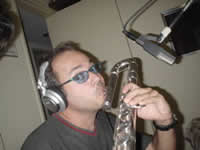 Em Tudo Coreto, cada uma das dez músicas tem uma sonoridade específica e, sem convidados, é um trabalho que mostra a realidade do grupo. Salva dos 21, por exemplo, é para Malta o "portrait" do Coreto Urbano. "Ela é a que mais revela a versatilidade da banda, pois passa pelo maxixe, funk, polca, frevo... Já Lamentos (Pixinguinha/Vinícius de Moraes) valoriza o ataque da nota, onde o que parece apenas um instrumento, é na verdade tuba e trombone baixo. E Luz do Sol (Caetano Veloso) tem uma melodia delineada com sax soprano", detalha.
Em Tudo Coreto, cada uma das dez músicas tem uma sonoridade específica e, sem convidados, é um trabalho que mostra a realidade do grupo. Salva dos 21, por exemplo, é para Malta o "portrait" do Coreto Urbano. "Ela é a que mais revela a versatilidade da banda, pois passa pelo maxixe, funk, polca, frevo... Já Lamentos (Pixinguinha/Vinícius de Moraes) valoriza o ataque da nota, onde o que parece apenas um instrumento, é na verdade tuba e trombone baixo. E Luz do Sol (Caetano Veloso) tem uma melodia delineada com sax soprano", detalha. 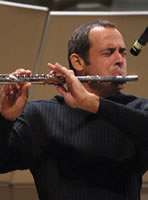 Enxutíssimo em suas dez músicas, o CD é uma viagem pela criatividade dos também dez músicos. Ainda paira sob a música brasileira aquela idéia de que instrumental não prende o ouvinte. Para contradizer o preconceito, aí estão Malta e seu grupo, que através da realidade de seu som trabalhado de forma pura e sem altas tecnologias de estúdio - o CD foi gravado no velho estúdio da rádio MEC, onde a acústica é o equipamento mais importante -, seduz os ouvidos mais desacostumados ao instrumental.
Enxutíssimo em suas dez músicas, o CD é uma viagem pela criatividade dos também dez músicos. Ainda paira sob a música brasileira aquela idéia de que instrumental não prende o ouvinte. Para contradizer o preconceito, aí estão Malta e seu grupo, que através da realidade de seu som trabalhado de forma pura e sem altas tecnologias de estúdio - o CD foi gravado no velho estúdio da rádio MEC, onde a acústica é o equipamento mais importante -, seduz os ouvidos mais desacostumados ao instrumental.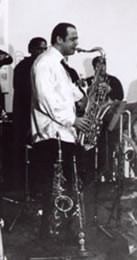 Now every time I write or say something about Carlos Malta, I find myself consciously holding back accolades. But he is undoubtedly one of the world's fastest and most imaginatively advanced improvisers, with a vision that streaks ahead of his flying fingers, throwing out whirlwinds of ideas in prodigal handfuls—beautiful melodic lines, cliff-hanging climaxes, startling tonal devices, the whole held together by a colossal drive. An exciting tone colorist and obvious master of extended techniques, Malta's open ears and senses led him early on to experiment with an ever-widening circle of possibilities, to abandon notions that the flute has only one basic tone quality and is capable of producing only one note at a time, and to radically expand the instrument's sonic resources, its sound envelope.
Now every time I write or say something about Carlos Malta, I find myself consciously holding back accolades. But he is undoubtedly one of the world's fastest and most imaginatively advanced improvisers, with a vision that streaks ahead of his flying fingers, throwing out whirlwinds of ideas in prodigal handfuls—beautiful melodic lines, cliff-hanging climaxes, startling tonal devices, the whole held together by a colossal drive. An exciting tone colorist and obvious master of extended techniques, Malta's open ears and senses led him early on to experiment with an ever-widening circle of possibilities, to abandon notions that the flute has only one basic tone quality and is capable of producing only one note at a time, and to radically expand the instrument's sonic resources, its sound envelope.  I worked closely with Carlos for ten years, and he was consistently brilliant in the handling of his vast arsenal of instruments. Additionally, he has a strong stage presence, and his own fine recordings attest to the quality of his musicianship."
I worked closely with Carlos for ten years, and he was consistently brilliant in the handling of his vast arsenal of instruments. Additionally, he has a strong stage presence, and his own fine recordings attest to the quality of his musicianship." 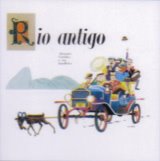
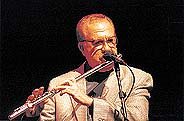 Depois de tocar tarol na banda Lira de Árion, começou a estudar flauta. Iniciou a carreira nos programas de calouros, tendo obtido o primeiro prêmio no Calouros em Desfile, de Ary Barroso. Fez fama como improvisador e participou de numerosos grupos, discos e shows. Em 1949 gravou seu primeiro choro, "Flauteando na Chacrinha", no ano seguinte montou seu próprio conjunto na Rádio Guanabara. Em 51 substituiu Benedito Lacerda no conjunto regional de Garoto, contratado pela Rádio Mayrink Veiga. Lá acompanhou grandes estrelas como Vicente Celestino, Orlando Silva e Francisco Alves.
Depois de tocar tarol na banda Lira de Árion, começou a estudar flauta. Iniciou a carreira nos programas de calouros, tendo obtido o primeiro prêmio no Calouros em Desfile, de Ary Barroso. Fez fama como improvisador e participou de numerosos grupos, discos e shows. Em 1949 gravou seu primeiro choro, "Flauteando na Chacrinha", no ano seguinte montou seu próprio conjunto na Rádio Guanabara. Em 51 substituiu Benedito Lacerda no conjunto regional de Garoto, contratado pela Rádio Mayrink Veiga. Lá acompanhou grandes estrelas como Vicente Celestino, Orlando Silva e Francisco Alves. 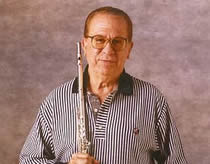 One of the most important choro flutists ever, Altamiro Carrilho put together a solid virtuosity and an ease for improvisation that in his 58 years as a professional artist (completed in 2001, having recorded over 110 albums) brought him the praise of both classical and popular renowned musicians, along with a consolidated popularity. His trademark was the insertion of excerpts of classical pieces into choro, and vice versa, as he did in the cadenza of the Concerto #2 in D Major KV 314 ahead of the Orquestra Sinfônica de Porto Alegre (1976). As an accompanist, he worked with Orlando Silva, Vicente Celestino, Elizeth Cardoso, Moreira da Silva, Francisco Alves, Sílvio Caldas, Caetano Veloso, and Chico Buarque, among many others. His maxixe "Rio Antigo" sold 960,000 copies in just six months back in 1956, bringing him national fame. Carrilho also presented the highly successful TV show Em Tempo de Música, and toured through many countries, having being praised as one of the world's best soloists by conductor Boris Trisno. As a classical music soloist, he played lead on several orchestra pieces like Mozart's Concert in G at the Teatro Municipal do Rio de Janeiro (1972). His album Clássicos em Choro was awarded with the Villa-Lobos trophy as Best Instrumental Album, and his Clássicos em Choro No. 2 won the gold record. In 1993, he was awarded with the Prêmio Sharp as the Best Arranger of Instrumental Music for his work on the album Altamiro Carrilho — 50 Anos de Choro, and, in 1997, he won it again for the Best Instrumental Album, Flauta Maravilhosa.
One of the most important choro flutists ever, Altamiro Carrilho put together a solid virtuosity and an ease for improvisation that in his 58 years as a professional artist (completed in 2001, having recorded over 110 albums) brought him the praise of both classical and popular renowned musicians, along with a consolidated popularity. His trademark was the insertion of excerpts of classical pieces into choro, and vice versa, as he did in the cadenza of the Concerto #2 in D Major KV 314 ahead of the Orquestra Sinfônica de Porto Alegre (1976). As an accompanist, he worked with Orlando Silva, Vicente Celestino, Elizeth Cardoso, Moreira da Silva, Francisco Alves, Sílvio Caldas, Caetano Veloso, and Chico Buarque, among many others. His maxixe "Rio Antigo" sold 960,000 copies in just six months back in 1956, bringing him national fame. Carrilho also presented the highly successful TV show Em Tempo de Música, and toured through many countries, having being praised as one of the world's best soloists by conductor Boris Trisno. As a classical music soloist, he played lead on several orchestra pieces like Mozart's Concert in G at the Teatro Municipal do Rio de Janeiro (1972). His album Clássicos em Choro was awarded with the Villa-Lobos trophy as Best Instrumental Album, and his Clássicos em Choro No. 2 won the gold record. In 1993, he was awarded with the Prêmio Sharp as the Best Arranger of Instrumental Music for his work on the album Altamiro Carrilho — 50 Anos de Choro, and, in 1997, he won it again for the Best Instrumental Album, Flauta Maravilhosa.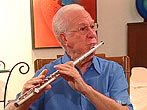 Having four generations of musicians and conductors in his genealogical tree, becoming a flutist at age five was somewhat natural for Carrilho. Since he was nine, he had started working because of his father's illness, but he continued to study music at night. At 11, he joined the Banda Lira de Arion playing the snare drum. When he was 16, he moved to Niterói (Rio de Janeiro) and became a regular at the radio shows presented by Dante Santoro and Benedito Lacerda. During that period, he won first place in Ary Barroso's novice show. His improvisational skills soon brought him invitations to join the groups led by César Moreno, Canhoto, and Rogério Guimarães. He recorded for the first time in 1943, on a Moreira da Silva album. His first record as a solo artist was recorded six years later, with his choro "Flauteando na Chacrinha." His own regional (small group) was formed in 1950 to work at the Rádio Guanabara. In May 1951, he joined the Regional do Canhoto, replacing Benedito Lacerda. Working at the Rádio Mayrink Veiga, the group accompanied the biggest stars of that period, like Orlando Silva, Vicente Celestino, Moreira da Silva, Francisco Alves, and Sílvio Caldas. In 1955, he formed the Bandinha de Altamiro Carrilho, and, in the next year, he achieved national success with his maxixe "Rio Antigo." Through the TV Tupi show Em Tempo de Música, he and his Bandinha attracted large audience levels for two years. In 1957, he was replaced by Carlos Poyares at the Regional do Canhoto. From 1963 to 1969, he did several international tours through countries like Spain, Portugal, France, England (where he recorded programs for the BBC and NBC), Germany, Lebanon, Egypt, and the former U.S.S.R. (for a three-month season in which he was praised by the conductor Boris Trisno as one of the world's greatest soloists). Carrilho continues to perform and record, and was decorated in 1998 by the President Fernando Henrique Cardoso for his services to the country.
Having four generations of musicians and conductors in his genealogical tree, becoming a flutist at age five was somewhat natural for Carrilho. Since he was nine, he had started working because of his father's illness, but he continued to study music at night. At 11, he joined the Banda Lira de Arion playing the snare drum. When he was 16, he moved to Niterói (Rio de Janeiro) and became a regular at the radio shows presented by Dante Santoro and Benedito Lacerda. During that period, he won first place in Ary Barroso's novice show. His improvisational skills soon brought him invitations to join the groups led by César Moreno, Canhoto, and Rogério Guimarães. He recorded for the first time in 1943, on a Moreira da Silva album. His first record as a solo artist was recorded six years later, with his choro "Flauteando na Chacrinha." His own regional (small group) was formed in 1950 to work at the Rádio Guanabara. In May 1951, he joined the Regional do Canhoto, replacing Benedito Lacerda. Working at the Rádio Mayrink Veiga, the group accompanied the biggest stars of that period, like Orlando Silva, Vicente Celestino, Moreira da Silva, Francisco Alves, and Sílvio Caldas. In 1955, he formed the Bandinha de Altamiro Carrilho, and, in the next year, he achieved national success with his maxixe "Rio Antigo." Through the TV Tupi show Em Tempo de Música, he and his Bandinha attracted large audience levels for two years. In 1957, he was replaced by Carlos Poyares at the Regional do Canhoto. From 1963 to 1969, he did several international tours through countries like Spain, Portugal, France, England (where he recorded programs for the BBC and NBC), Germany, Lebanon, Egypt, and the former U.S.S.R. (for a three-month season in which he was praised by the conductor Boris Trisno as one of the world's greatest soloists). Carrilho continues to perform and record, and was decorated in 1998 by the President Fernando Henrique Cardoso for his services to the country.
 Br-Instrumental no Twitter
Br-Instrumental no Twitter




